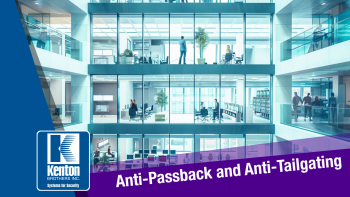Anti-Passback and Anti-Tailgating: Do you know who is in your building?
By Neal Bellamy, IT Director at Kenton Brothers
Do you know who is in your building? Do you know where everyone is located when they are in your building?
To help companies answer these questions, we use access control solutions. (As the name implies, these solutions control access to buildings.) When configuring these systems, we decide which people get into the building, which doors they can use and the times that they are able to open the door. Access cards are a key component of these systems.
Access Card Skimming Devices
 There are reasons why you might want to increase security or safety by adding more features to your current access control system. Why? Copying and emulating an access card has become easier, due to new technology like a flipper zero and other skimming devices.
There are reasons why you might want to increase security or safety by adding more features to your current access control system. Why? Copying and emulating an access card has become easier, due to new technology like a flipper zero and other skimming devices.
The best defense against copying a card is to use a card technology that has not yet been hacked. You also need to use encrypted communication between the reader and the control panel. (Both have been talked about before in my previous blogs). However, sometimes the upgrade path can take a long time to implement and/or be expensive depending on how large your system is and how old it is. Another way to guard against skimmers might be to ensure a card has only been used once to gain entry.
Anti-Passback
 Anti-passback is the access control term when we want to prevent someone from entering a door and then passing back the card to another person, who then uses the card to enter. Most access control systems have that technology available. When this feature is enabled, you also know when a person is leaving the area. If you know when they are in the area and you know when they leave an area, then you also know where they shouldn’t appear in the building. In other words, if the cardholder is already in the building, you should not grant access to the building again.
Anti-passback is the access control term when we want to prevent someone from entering a door and then passing back the card to another person, who then uses the card to enter. Most access control systems have that technology available. When this feature is enabled, you also know when a person is leaving the area. If you know when they are in the area and you know when they leave an area, then you also know where they shouldn’t appear in the building. In other words, if the cardholder is already in the building, you should not grant access to the building again.
The reason an employee might try to get into the building again is because they loaned their card out, or because it was copied. Anti-Passback also provides more safety. If an emergency happens, you also know who was in the building or area at the time of the event. If you don’t have Anti-Passback enabled, you might know that a person came in that morning, but would not know that they left for lunch or an appointment during a specific timeframe.
To build on this example, imagine a multi-building company or a company located across multiple cities. If someone badged into the downtown campus and has not badged out, then they can’t possibly be at the uptown office. If they were in the New York office at 8am, there is no way they could be badging into the L.A. office at 9am.
Anti-Tailgating
You can also define areas within areas. You might have a building perimeter, then a lab inside, and maybe even a hazardous storage area inside the lab. You can set the rules so that they cannot enter the storage area unless they are in the lab first; You can’t enter the lab until they are in the building; and so on. (This technically is called Anti-Tailgating, but goes hand-in-hand with Anti-Passback.)
There are a few reasons you might want to know in real-time who is in your building. Anti-Passback and Anti-Tailgating can improve security by only allowing one person to be in one place, improve safety by knowing that someone was in the building during an emergency, and even help you understand where in the building someone is located.
We are experts at solving hard problems, if you have a unique situation, please let us help.




Leave a Reply
Want to join the discussion?Feel free to contribute!